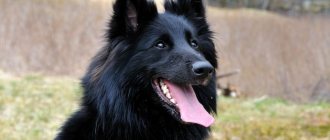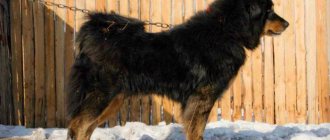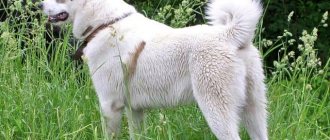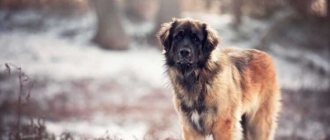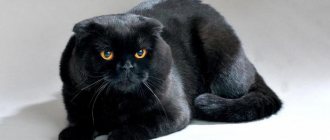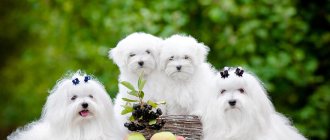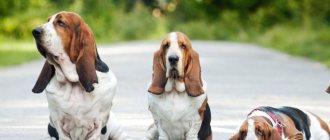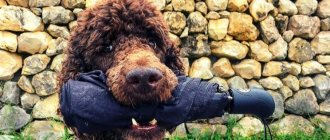Jet black and incredibly intelligent, Groenendaels are Belgian Shepherd Dogs. All over the world they are valued not only for the incredible beauty of their wool, as one might think. Rescuers and police officers around the world note the dogs' courage, endurance and high intelligence, which allows them to make independent decisions in dangerous situations. Is this dog difficult to care for? Is it possible to raise your rescuer at home? All the answers are in that article.
Breed traits
Breed traits (on a 5-point scale)
| Belgian Shepherd Groenendael | |||
| Activity | in the house | 3.2 | |
| on the street | 4.8 | ||
| Obedience | training | 4.8 | |
| strangers | 3.8 | ||
| Domination | in family | 2.2 | |
| over dogs | 3 | ||
| Defending your territory | from people | 3.6 | |
| from dogs | 4.2 | ||
| Sociability | in family | 5 | |
| with strangers | 2.6 | ||
| with dogs | 2.6 | ||
| Concentration | in family | 1 | |
| in front of strangers | 3.8 | ||
| with dogs | 3.6 | ||
| Aggressiveness | in family | 1.2 | |
| to strangers | 2.4 | ||
| to the dogs | 3 | ||
| to cats | 3 | ||
| Family behavior | calmness | 5 | |
| demand for affection | 5 | ||
| excitability | 4 | ||
| playfulness | 4.4 | ||
| excessive barking | 2.4 | ||
| behavioral breakdowns | 2.4 | ||
| Tolerance for children | up to 4 years | 3 | |
| over 4 years old | 3.8 | ||
| Institutional use | watchman | 5 | |
| bodyguard | 3.2 | ||
This breed is often compared to the following dog breeds: German Shepherd, Belgian Tervuren Shepherd, Hungarian Shorthair Vizsla, Belgian Malinois, Schipperke.
The photo shows what Groenendael looks like:
Training and education of the Groenendael
Every day your dog needs at least two hours of vigorous physical activity. If you enjoy hiking or jogging, your shepherd will be happy to be around.
A puppy of this breed must be taught from early childhood to foreign sounds, smells, and different terrain. He is very shy, although he is curious.
The Groenendael is highly trainable and accurately follows the commands given by its owner.
From 9 weeks to 4 months, your puppy needs exercise and 15-20 minutes of mental exercise in the morning and evening. You need to start with simple tasks, for example, throw a ball to your baby and ask him to bring it back to you.
At the age of 4-6 months , the dog needs at least a half-kilometer walk and 20-30 minutes of mental exercise twice a day. Starting from of six months , training should take at least 40 minutes in the morning and evening every day.
After a year, the dog should run at least one and a half kilometers every day. However, hard surfaces such as asphalt and concrete should be avoided.
Groenendael is incredibly smart and highly trainable . In order to succeed in training, the owner must earn his trust and respect. Anger, intimidation or physical force should not be used against this breed.
For all his strength and confidence, the Groenendael is unusually sensitive , which means that the owner’s harsh behavior can harm his temperament. The best way for an owner to communicate with a dog is through a combination of consistent commands and rewards for correct behavior.
Characteristics of the Belgian Shepherd Groenendael breed
The Groenendael is a type of Belgian Shepherd with black fur. The name translates as “green valley”. These dogs are brave, hardworking, strong. They are unpretentious, easily adapt to any conditions, and are smart. They are a national treasure of Belgium.
Groenendaels are hardy and intelligent dogs that are capable of any job. They can protect the house, be used as official ones: in the police, customs. They can make decisions independently in difficult situations. This is an excellent guide, rescuer, bodyguard, companion. He easily learns tricks and shows good results in agility, canicross and other types of dog sports.
| Options | Characteristic |
| breed name | Belgian Shepherd Groenendael (Dutch Groenendael) |
| a country | Belgium |
| time | late 19th century |
| group of breeds according to the ICF classification | herding and cattle dogs, shepherd section |
| application | service dog, companion |
| life expectancy | 11-13 years old |
| height | males 60-66 cm, females 56-62 cm |
| weight | males 25-30 kg, females 20-25 kg |
| activity | high |
| aggression | No |
| intelligence | high |
| care | simple |
| health | good |
pros
The Groenendael is an intelligent, loyal and hard-working dog. It was bred for independent grazing and protection of livestock and home protection. Now this is the ideal companion for an active owner. Representatives of the breed have several advantages:
- attractive appearance;
- they are smart, easy to train, understand the rules of behavior;
- cheerful, active and playful;
- loyal, attached to all family members;
- love children and are patient with them;
- get along easily with any pets, do not enter into conflicts with other dogs;
- have pronounced watchdog and security qualities, are able to act independently in a critical situation;
- efficient, unpretentious.
Minuses
Belgian Shepherds are very active and energetic. They require regular physical activity. Therefore, the breed is not suitable for homebodies, elderly people and those who cannot pay enough attention to their pet. Inexperienced dog breeders should not get a Groenendael. An owner who cannot gain authority will not become a leader for this dog. Representatives of the breed have several more disadvantages:
- love of freedom, tendency to escape;
- the need for regular classes and training;
- without sufficient physical activity they can damage furniture and things;
- they are very emotional and can be touchy;
- The fur sheds a lot, and when wet it smells like a dog.
Brief characteristics of Groenendael
For those who don’t have time to read a long article – the strengths and weaknesses of the breed based on owner reviews:
Advantages:
- The Groenendael Shepherd looks spectacular.
- Loves to learn new things and remembers commands easily.
- Vigilantly guards the site, house, property.
- Will be able to protect the owner and family in a moment of danger.
- He treats children kindly, protects children, and listens to schoolchildren.
- Will be an excellent companion for outdoor enthusiasts.
- Does not require complex care.
- Has strong immunity and good health.
Flaws:
- Does not tolerate loneliness and a sedentary lifestyle.
- Needs long walks, regular exercise and mental stimulation.
- Without constant care, wool quickly becomes tangled.
- Sheds profusely in winter and summer.
To fully develop their innate abilities, they need early socialization, training, and proper care.
History of the origin of the Belgian Shepherd Groenendael breed
Herding dogs have been popular in Belgium since ancient times. They helped people not only herd livestock, but also protect it, as well as the farmstead and the owner. At that time, they didn’t think about breeding any breed; dogs were bred taking into account only working qualities. They lived mainly with farmers.
Only at the end of the 19th century did the selection of Belgian Shepherds begin. A professor at the veterinary institute, Adolf Riyul, took charge of it. For breeding, he selected the strongest and largest individuals and ensured that they were healthy. Since shepherd dogs differed in the quality of their coat, the professor identified 4 breed varieties.
A club for Belgian Shepherd lovers was created. They began to be called after the names of the areas in which one or another type was common:
- Groenendael;
- Malinois;
- Laekenois;
- Tervuren.
These varieties are subtypes of the Belgian Shepherd breed. Crossing them is prohibited. And the American Kennel Club considers them separate breeds. Groenendael, as a variety of Belgian Shepherds, appeared in 1898, when two black dogs were born in the same kennel.
The International Canine Association recognized the breed in 1909. Gradually it spread around the world and became popular. Due to two world wars, the number of representatives of the breed greatly decreased, but fanciers preserved and restored it.
In the 30s of the 20th century, Groenendael was used in breeding German shepherds. The breeders wanted a black color. But puppies with narrow muzzles began to be born, this experiment was stopped. Crossbreeding is now prohibited
History of the Groenendael dog breed
Belgian Shepherds are descendants of herding dogs. Shepherd dogs skillfully managed sheep and were famous for their strength, endurance, and hard work. But outwardly they were very different.
In 1891, the owners decided to create a national breed and organized the Belgian Shepherd Club in Brussels. At the first exhibition, 40 dogs were selected for breeding. A year later, they developed a standard for shepherd dogs of three types of coat: long, short and hard.
The first breeder of black long-haired shepherd dogs was Nick Rose from the town of Groenendaal, 5 km from Brussels. He ran a pub, the Chateau Groenendaal, and in 1893 opened a nursery.
One day, Rose discovered a black puppy in the litter, which he named Packard. When the pet grew up, he found a mate for him - a dog with a similar exterior named Malyutka. The mating of Packard and Malyutka marked the beginning of the line of black Belgian Shepherds.
Groenendaal at the beginning of the 20th century.
On March 12, 1898, Rose registered the grown-up pets from the first litter of Packard and Baby and showed them at the exhibition. They impressed the jury and the public with their uniform appearance.
In 1901, Rose started his first stud book and named the dogs Groenendael after his pub. This year marked the beginning of the pedigree of all purebred black Belgian Shepherds with long hair. In 1909, the breed was recognized by international canine organizations and included in catalogs, retaining the name of the first breeder.
Use of Groenendael dogs
Initially, black Belgian Shepherds worked as shepherds and livestock guards, just like their ancestors. But already in 1899, the first dogs were hired by the police of the Belgian city of Ghent. This initiative was supported in other cities and outside Belgium.
During the world wars, the Groenendaels took part in hostilities. They found mines, delivered mail, served as security guards, and demolitionists. The number of animals decreased sharply after the wars. During the restoration of the stock, breeders did not cross Groenendaels with other lines and breeds. Now they look like they did 100 years ago.
In Belgium, cattle breeders still willingly take Groenendaels as assistants. They successfully compete in competitions and remain in shape for up to 10 years. The structure and proportions of the body help to win prizes in agility. Dogs can instantly change direction at high speeds of 5 m/s and overcome barriers with a margin.
Groenendael Athena – Norwegian champion in agility.
Grunendels master any courses: protective guard service, search and rescue, search. They serve in the police, the Ministry of Emergency Situations, at the border, in customs, and work as guides and assistants for the disabled. Grunendels make loyal domestic companions and family dogs.
Appearance Standard
This dog looks elegant and strong. A muscular, harmonious physique, a graceful head posture, and swift movements are her characteristic features. The main difference from other varieties of the breed is its thick black coat. The nose, lips, eyelids, and claws are also black.
Head
The skull is oblong, proportional to the body. The muzzle is long, graceful, wedge-shaped, tapering towards the nose. The occipital protuberance and brow ridges are not pronounced. The transition from forehead to nose is smooth. The cheeks are flat, the lips are thin. The jaws are strong and have a scissor bite. The bridge of the nose is smooth, the lobe is black, large.
The eyes are almond-shaped, medium in size, and slanted. Should be dark brown in color. The look is lively, intelligent and attentive. The ears are triangular and small. Set high, erect.
Frame
The body is athletic, with pronounced muscles, proportionally built, square in shape. The neck is elongated, gracefully curved. The chest is deep, reaching to the elbows, and the ribs are arched. The back is wide, flat, the loin is sloping. The abdomen is moderately tucked.
The tail is thick at the base, set low, and of medium length. Abundantly covered with hair. When at rest it hangs, the tip can be bent upward. An excited dog may pick it up. But the tail is never thrown over the back or bent in a hook.
Limbs
The limbs are muscular. The front ones are straight, thin, set parallel. Hind with pronounced muscles and hock joints. The paws are round, the toes are arched, tightly compressed, with thick pads. The Groenendael moves freely, has a springy, light gait, and runs quickly. Capable of abruptly changing direction at high speed and jumping high.
Coat and color
The skin is elastic, fits tightly and does not form folds. The coat is long - 10-15 cm. The guard hair is straight, smooth, the undercoat is soft and thick. This cover provides good thermoregulation and protects against temperature changes. The wool forms a wide collar and pants on the legs. Shorter on the head and paws.
Representatives of this breed are only black in color. Perhaps a small white spot on the chest, speckles between the toes. The coat can be matte or have a slight silver tint. A reddish or rusty tint is not desirable.
The photo complements the description of the Groenendael's appearance:
Health and life expectancy
Groenendael enjoys good health, but is susceptible to hip or elbow . When purchasing a puppy of this breed, you need to make sure that the parents do not have problems with the joints.
Another serious hereditary disease is epilepsy . If convulsions or tremors are noticed in the body, it is necessary to urgently show the animal to a veterinarian for an accurate diagnosis and recommendations for treatment.
Groenendael is susceptible to a disease called progressive retinal atrophy , which can lead to complete blindness of the animal.
A fairly rare, but very dangerous disease is hypothyroidism - an abnormally low level of the hormone produced by the thyroid gland. Characterized by infertility, obesity, mental inhibition. The dog's fur begins to fall out and the skin becomes tough. There is no cure for this, but with proper daily therapy, the animal can live a full life.
Like humans, this shepherd has a predisposition to cancer . Groenendael is also susceptible to various allergic reactions (both to food and to some medications). Due to improper nutrition, dogs of this breed may develop bloating or volvulus.
The lifespan of a Groenendael is 10-12 years .
Groenendael character
This is a cheerful, inquisitive and intelligent dog. There are many merits in his character and behavior. With proper upbringing, he will delight his owners and will never cause problems.
This dog is loyal, affectionate, unpretentious. Has a calm, balanced temperament. It easily adapts to the owner's lifestyle. The only thing the Groenendael needs in return is attention and a sufficient amount of physical activity. He is ready to help the owner in everything and work in any conditions. Easily withstands bad weather.
Groenendael has pronounced guard qualities and does not show fear of danger. He always bravely rushes to protect the owner and his property. Although there is no aggression towards a person in his character. The dog treats all family friends kindly.
This dog becomes attached to all family members. Like a true shepherd, she takes the small and weak under her protection. Therefore, she will become the best nanny for the child. He will never bite a baby, is patient, loves to play. But if the child's attitude towards him becomes disrespectful or rude, he may become offended and stop communicating. This dog is also protective of all pets. He will shepherd them, stop conflicts, protect them.
Education and training
The Groenendael is one of the best working dogs. They can work in the police, customs, army, search and rescue services. Experts often choose them instead of German Shepherds, as they are more hardy and efficient. These dogs work as guide dogs and are used in canistherapy. The best owner for them would be a person leading an active lifestyle, an athlete, or a traveler.
The working qualities of the Groenendael are genetically determined. But they still need to be trained and educated from an early age. To do this, you need to establish contact with the dog and gain authority from it. Then the Groenendael will try to please the owner and will gladly carry out any commands. And he learns them quickly and learns tricks easily. He does not need a treat as a reward; praise and affection are enough.
Character and temperament
The Groenendael is the most loyal breed , distinguished by incredible speed, strength, endurance and excellent health.
Another character trait is excessive energy , due to the instincts of herding dogs. Therefore, this breed is not suitable for people who are away from home for a long time, leaving the pet inactive. Bored, the pet may start to have fun on its own, which will certainly end in damage to property. By the way, boredom is the main reason why it is not recommended to keep a shepherd in an apartment.
Groenendael has the ideal temperament. This depends on a number of factors such as heredity, training and socialization.
The Shepherd is endlessly friendly , which makes it a wonderful friend for children and other family members. But such friendliness does not extend to the threat that has arisen for the owner or his loved ones, which forces the pet to defend itself without hesitation.
In addition, the Belgian is the “owner” of the territory, which often becomes the cause of conflict with those who have even slightly “encroached” on his property. In order to avoid such conflicts , dog breeders recommend starting training as early as possible.
Maintenance and care
The Groenendael has a thick coat and can be kept outdoors. Just don’t put them on a chain or in a small enclosure – they need space. They will guard the house and territory. Although they get along well in a city apartment. You just need to walk him on time and provide physical activity. You need to walk this dog 2-3 hours a day.
When kept at home, grooming can create problems. She sheds heavily and may have a dog smell. It needs to be combed out regularly with a wide-toothed metal comb. During the molting period, you still need to use hard brushes and slicker brushes. It is often undesirable to bathe the Groenendael; 2-4 times a year is enough. But after each walk you need to wash your paws and belly fur.
Other hygiene procedures are also simple. You need to examine and wipe your eyes and ears. These dogs are not prone to inflammatory diseases. There is also no need to frequently brush your teeth or trim your nails.
Nutrition
Groenendael requires a diet high in protein. Premium or super-premium dry food is best. You need to choose options for active dogs of large breeds; Brit, Belcando, Go!, Orijen, Grandorf are suitable.
If the owner chooses natural food, at least 70% of the diet should be protein foods. This includes lean meat, offal, eggs, sea fish, and dairy products. They need to be supplemented with vegetables, fruits, and porridge. Be sure to give vitamin supplements as recommended by your veterinarian.
You should not give your pet fatty, salty, spicy foods, smoked foods, canned food and marinades. Sweets, baked goods, legumes, and citrus fruits are prohibited.
Health
Like all Belgian Shepherds, Groenendaels have good health. They are hardy and with proper care can live up to 13-15 years. But sometimes they have genetic diseases:
- joint dysplasia;
- epilepsy;
- retinal atrophy;
- food allergies;
- cardiovascular pathologies.
When kept in apartments without sufficient exercise, these dogs often develop obesity, diabetes, and depression. They may become aggressive, become sad, and stop listening.
Description of the Groenendael dog breed
The Belgian Shepherd family includes 4 species: Malinois, Groenendael, Tervuren, Laekenois. The FCI united them into one breed and developed a single standard. The differences relate to the texture, color and length of the coat.
The first draft appeared in 1892, then it was corrected more than once. The latest version was published in 2001. The US Kennel Club recognizes only Groenendaels as Belgian Shepherds. He considers Tervuren and Malinois to be independent breeds, but refuses to register the Laekenois at all.
The appearance of the Groenendael combines strength and elegance.
These are muscular and at the same time graceful animals with an intelligent, studying look, alert straight ears. Hidden energy and readiness for action are noticeable even in a static position.
The average height of males is 64 cm, body weight is 30 kg. Bitches look more graceful, height at withers – 58 cm, weight – 25 kg.
General requirements for the exterior of Belgian Shepherds are outlined in detail in the characteristics of Malinois dogs. Separately for Groenendaels, the standard describes only the coat. It consists of dense, dense guard hair of medium hardness and a silky, soft undercoat. Length uneven:
- The body is covered with long, straight hair.
- Short hair grows on the head, outer surface of the ears, and at the bottom of the legs.
- The neck and chest are decorated with a collar and jabot.
- At the base of the ears, slightly raised hair beautifully frames the sides of the head.
- Thick fringes grow on the back of the thighs.
- Tail – with abundant long hair and fluff at the end.
The standard allows only one color for the Groenendael - uniformly black. Small white spots are allowed on the fingers and chest. Any deviations are considered deficiencies:
- coat that is too soft or semi-long;
- wavy, curly hair;
- red, gray blotches;
- light “tie” on the neck, white markings on any areas except the fingers and chest;
- pink spots on the nose, lips, eyelids, claws;
- light brown iris.
Dogs with deviations are not allowed to show and are excluded from breeding.
Character of the Groenendael dog
Black Belgian Shepherds have inherited the working qualities of herding dogs - the ability to herd, guard, protect.
Smart, observant animals are able to make decisions without orders from the owner. Peace-loving dogs in ordinary life instantly turn into brave defenders if they sense danger to their home and family.
On the other hand, they are naturally obedient, able to obey and follow commands. If you take the time to raise and train, the puppy will grow into a balanced, easy-going dog.
Groenendael more often recognizes one owner, but is always happy to receive the attention of the rest of the family. Sensitive dogs can instantly determine the emotional mood of family members by gestures, facial expressions, and intonation.
Groenendaals are attentive and strict watchmen. This property is in the blood and there is no need to specially train your pet. But they are not put on a chain, they are not kept on a leash for days. Groenendaels need movement, communication, exercise and long walks.
Trained dogs are loyal to strangers if they do not threaten the safety of the family. Young animals are introduced to new people carefully, without letting them off the leash. A pet may behave aggressively due to a highly developed protective instinct. But he quickly calms down if he sees the owner’s friendly attitude towards the stranger.
Groenendael is peaceful with pets as long as they grow up together. An adult dog does not show open aggression towards a new pet, but does not show love either. On the street, a dog can hunt other people's cats.
Groenendael and children
A trained dog often directs the instincts of a shepherd, guard and protector to a preschool child. Carefully watches the baby, controls his actions, protects him from strangers.
However, the Groenendael will not become a constant playmate if the child pulls its tail, fur and ears. The dog will not offend the baby, but will not tolerate inept treatment and will step aside.
A trusting relationship develops when a puppy enters a family with a child of 6–7 years old, and they grow up at the same time. There will always be agreement in this couple, and there will be common interests. First, outdoor games, as they grow older - sports activities, training. Groenendaal gets along well with a schoolchild, obeys, and does not try to dominate.
Raising a puppy and behavior of adult dogs
Belgian Shepherds require early socialization. If the puppy is kept isolated from the outside world, behavior problems will arise in the future. The dog grows up either too fearful, nervous, or shows unnecessary aggression. This is noticed even in naturally balanced animals.
It is useful to take a Groenendael puppy with you everywhere, gradually increasing the psychological load:
- From 3 months after scheduled vaccinations, the pet is taken outside, where it learns new sounds and smells.
- During walks, they change routes so that he feels more confident in unfamiliar places.
- From childhood, people are taught to ride calmly in public transport and in a private car.
- As early as possible, introduce new, friendly people, dogs, cats, children.
The more diverse the impressions at an early age, the more calm and restrained the puppy will grow up. The behavior of an adult Groenendael depends on the lifestyle that the owner offers him. If you take your dog for a long walk and exercise, then there won’t be any problems.
With a lack of movement, attention, and mental stress, the pet comes up with activities on its own. At home he chews things, runs around and knocks everything around. On walks he digs holes, runs away, and runs in circles.
Training
The Groenendael has all the prerequisites for training:
- sharp mind;
- observation;
- good memory;
- instant response;
- ability and desire to learn new things;
- hard work.
These qualities help you learn new skills on the fly. Groenendaal remembers commands after 3–4 repetitions and learns tricks as a joke. If the pet does not complete the task, it means the owner is doing something wrong. For the basics of training, see the article Training dogs at home.
The puppy begins to engage in playful activities from the age of 3 months. During training, the Groenendael works tirelessly, trying to please the owner and gain approval. Praise is a strong incentive for him to work. Shouting, tugging, and intimidation disrupt contact and inhibit learning. The dog either withdraws or becomes disobedient and tries to dominate.
Health
Grunendels live 11 – 13 years, rarely up to 15. Working qualities have been developed in Belgian Shepherds for centuries. Beautiful but weak dogs were not taken for breeding. Therefore, good health and strong immunity have become breed characteristics. They rarely get sick, but in some lines hereditary diseases are transmitted:
- retinal atrophy, cataract;
- dysplasia of the hip joint, less often of the elbow;
- dysfunction of the thyroid gland;
- epilepsy;
- allergies to detergents, food ingredients.
Groenendaels become very attached to their owner. Particularly sensitive dogs develop depression if the owner leaves or is left alone for a long time.
How to buy a Groenendael puppy
Groenendael is a rare breed in our country, so the price of a puppy remains high. In Moscow, such dogs cost from 40 to 120 thousand rubles. It is better to contact a breed nursery or a responsible breeder. Such people can be found at dog shows or through comments on dog websites. Although the price for a puppy in a kennel will be higher than at home, this is a guarantee that the dog will be purebred and not a crossbreed from a German shepherd.
In addition to the pedigree, veterinary certificates and information about exhibitions and awards of the parents, it is important to pay attention to the appearance of the puppies. The following signs indicate that they are purebred:
- narrow, elongated muzzle;
- square body;
- tall slender limbs;
- The puppies are smaller in size than German Shepherds.
It is recommended to pay attention to the most cheerful, inquisitive puppy. He should not be afraid of loud sounds or unfamiliar people. Experts recommend taking the baby who runs up on his own.
The photo shows what the puppies look like:
The video will complement the description of the breed:
Video: Groenendael - a breed of black long-haired Belgian Shepherds
Video: Belgian Shepherd Groenendael. Breed characteristics, care
The Groenendael is a good dog for a family with children or an active owner; it can be a vigilant guard and a devoted companion. But for this you need to walk, run, and exercise with her a lot. This dog requires constant communication with people.
Groenendael dog kennels
Here is a list of nurseries that have positive reviews:
- "Star Wolf", Moscow;
- “From Krasnaya Gorki”, Pokrovskoye village, Moscow region
- “From Solnik”, Moscow;
- "Parfait Guard", Moscow t. 8-910-490-67-70
The price of a Groenendael puppy in good nurseries starts from 45 thousand rubles. They sell it 2-3 times cheaper, but you can buy a dog with congenital physical or behavioral abnormalities.
Groenendael dogs make excellent home companions for energetic people. Before bringing a puppy into your home, it is better to assess in advance your physical strength and free time for raising, training and daily long walks.
How to choose a Belgian Shepherd puppy
Groenendael puppies require the most attention of all Belgian Shepherds. At an early age they are overly active and require constant physical and intellectual stress. Before buying a puppy, you need to soberly assess the condition and size of the home, check for allergies in family members, and make sure you have enough time and finances for the pet. You should not buy an animal from a photo or video: there is a high risk of getting not a purebred Groenendael, but an ordinary mongrel. You can only buy a puppy from a professional breeder or nursery.
Rules for choosing and preparing for the arrival of a new family member:
- Talk to your puppy before you adopt him into your family. The animal also has the right to choose, and the Groenendael may not like you for a number of reasons.
- Make your home safe for your puppy in advance. There should be no plants, personal belongings, or electrical appliances in the public domain.
- Form a training strategy and distribute the care of the animal among family members.
- Choose only a well-groomed, active puppy, with clean skin and mucous membranes. Check your baby for hernias (bulges in the navel area).
- Play with the puppy. If he ingratiates himself in every possible way, tries to pay attention, behaves friendly and affectionately, you can safely take your pet home. Experienced dog breeders say that it is necessary to feel a connection with the dog, to feel love and affection for it.
The price of Belgian Shepherd puppies starts from $500. If you want to save money, you can consider purchasing a dog from a private breeder. In this case, the price will be slightly lower - about $350. However, we must not forget to carefully check the pedigree and veterinary passport of the animal, which should contain information about vaccinations.
Choosing a puppy
Despite the growing popularity, the Groenendael remains a rare breed in our country, and accordingly, the cost of a Black Belgian puppy is also high. A baby with show potential can be bought for two thousand dollars, and a “pet” is half that price. An inexperienced person can easily contact scammers who, at this price, will sell not an exclusive Groenendael, but a small black German, or even a mongrel.
What to pay attention to so as not to be deceived:
- first of all, on the muzzle - it should be not overgrown, narrow and elongated; a German’s “face” looks completely different;
- on the body format - it differs radically in the two breeds (the Groenendael is squared, and the German Shepherd is stretched);
- on the limbs - the Belgian Shepherd's legs are higher, drier, slimmer and less hairy than those of the German;
- on the coat - the undercoat of the Groenendael is more developed, and the awn is less adjacent to the body, the “pants” and “collar” are much more luxurious than those of the German.
It is more difficult to compare the size of puppies, since an inexperienced buyer is unlikely to be able to determine the exact age of the baby by eye, but it must be taken into account that German shepherds should be larger and heavier than Belgian ones at any age.
Get ready, your dog will choose you
Buy a small Groenendael only from a reputable nursery and enter into an agreement with the breeder on mutual obligations - this is a very useful document for both parties, which will also guarantee the breed of the puppy and its health. Try not to make such an important purchase in absentia; it is important to personally pick up your dog. On the spot you will receive a lot of useful information and make a better choice.
Watch how kids run and play: movements can tell a lot about health, and behavior in games can tell about character. Choose the most active, inquisitive and self-confident person.
However, most likely, your dog will choose you. This happens very often, and this is the right choice.
If you don’t want destruction in your home, provide your puppy with toys and interesting activities.
Features of the breed and character of the Groenendael
The name of the breed does not come from the locality of the same name, as many might think. The restaurant of the official founder of the breed, Nicholas Rose, was called “Chateau Groenendaal”. The man lived near Brussels in his own house with his pet, a black shepherd dog named Picard.
Having set out on the idea of creating a new breed, Rose chose a friend for his dog who was similar in appearance - a long-haired black dog named Malyutka. It was this couple that became the basis of the new Groenendael breed .
At the first exhibition (1891), where 117 similar black herding dogs were presented, 40 were selected, among which was Malyutka. Her grandson, a male named Misart, became the first champion in the Groenendael line.
The First World War made its own adjustments to the history of the breed. Groenendaels, along with other shepherd dogs, were used in front-line work: they were rescuers, sappers, demolition men, and security guards.
Only God knows how many innocent four-legged victims fell in those years due to human strife. The breed was on the verge of extinction. But the Belgian Groenendael was saved, and without resorting to crossing with other lines. Today we see them as they were a hundred years ago.
It is important to note that the Groenendael, like many other service breeds, was bred without the participation of specialists in the field of cynology and genetics. The best were selected based on working qualities and endurance; external characteristics were secondary, since these animals were intended for work, and not for showing off at exhibitions.
The Groenendael's character is decisive and stubborn. These animals combine intelligence, high intelligence and a predisposition to training with tremendous performance and endurance, making them ideal working dogs.
The Groenendael is very attached to its owner and is often chosen as a companion dog. They are happy to serve and benefit people. The development of working qualities is the result of proper upbringing and regular training with your pet. Not a single puppy without appropriate investment from a person will become a service dog that understands what is wanted from him.
In relation to other animals, Groenendals prefer to be reserved; getting used to new four-legged animals in the family occurs gradually.
Character
Belgian shepherd dogs have always been distinguished by their high intelligence and ease of training, as well as enhanced guarding qualities. In Europe, this breed, along with Swiss and Australian shepherds, serves in rescue and police services. According to the breed standard, they must have the following temperament traits:
- independence;
- independence in dangerous situations;
- bravery;
- endurance;
- high psychological stability;
- mobility;
- devotion;
- calmness.
Puppies have most of the qualities from birth, however, if they deviate from the norm in the form of aggression or passivity, such defects are corrected by training and education.
Many note the love of Groenendaels for children, but there is a caveat - they are excellent nannies, but when playing with children they can accidentally harm them, so you should not leave very young children alone with the dog.

